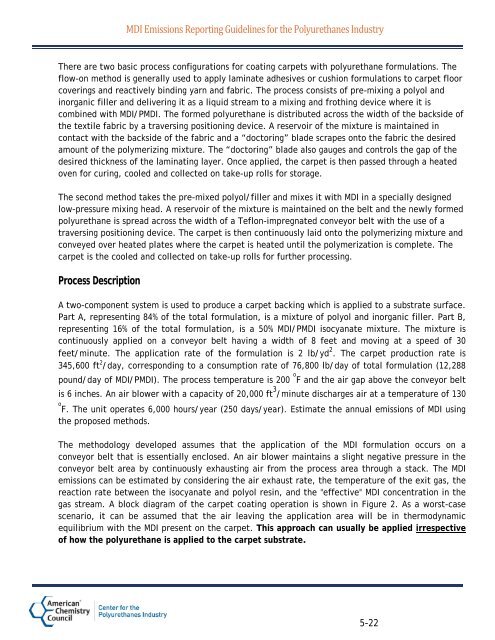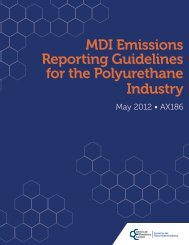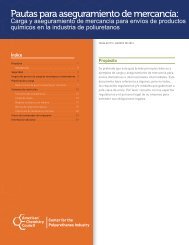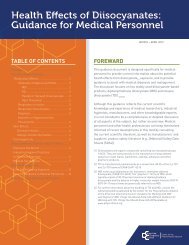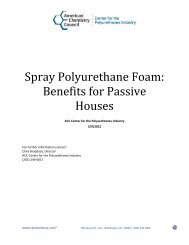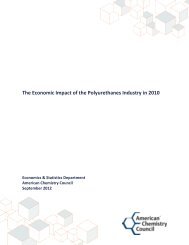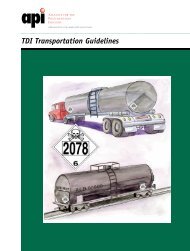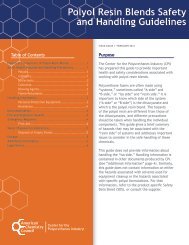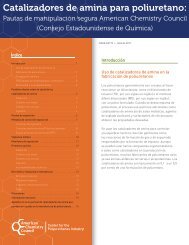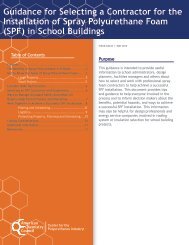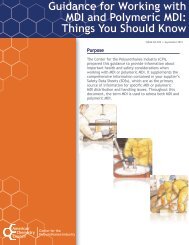MDI Emissions Reporting Guidelines for the ... - Polyurethanes
MDI Emissions Reporting Guidelines for the ... - Polyurethanes
MDI Emissions Reporting Guidelines for the ... - Polyurethanes
Create successful ePaper yourself
Turn your PDF publications into a flip-book with our unique Google optimized e-Paper software.
<strong>MDI</strong> <strong>Emissions</strong> <strong>Reporting</strong> <strong>Guidelines</strong> <strong>for</strong> <strong>the</strong> <strong>Polyurethanes</strong> Industry<br />
There are two basic process configurations <strong>for</strong> coating carpets with polyurethane <strong>for</strong>mulations. The<br />
flow-on method is generally used to apply laminate adhesives or cushion <strong>for</strong>mulations to carpet floor<br />
coverings and reactively binding yarn and fabric. The process consists of pre-mixing a polyol and<br />
inorganic filler and delivering it as a liquid stream to a mixing and frothing device where it is<br />
combined with <strong>MDI</strong>/P<strong>MDI</strong>. The <strong>for</strong>med polyurethane is distributed across <strong>the</strong> width of <strong>the</strong> backside of<br />
<strong>the</strong> textile fabric by a traversing positioning device. A reservoir of <strong>the</strong> mixture is maintained in<br />
contact with <strong>the</strong> backside of <strong>the</strong> fabric and a “doctoring” blade scrapes onto <strong>the</strong> fabric <strong>the</strong> desired<br />
amount of <strong>the</strong> polymerizing mixture. The “doctoring” blade also gauges and controls <strong>the</strong> gap of <strong>the</strong><br />
desired thickness of <strong>the</strong> laminating layer. Once applied, <strong>the</strong> carpet is <strong>the</strong>n passed through a heated<br />
oven <strong>for</strong> curing, cooled and collected on take-up rolls <strong>for</strong> storage.<br />
The second method takes <strong>the</strong> pre-mixed polyol/filler and mixes it with <strong>MDI</strong> in a specially designed<br />
low-pressure mixing head. A reservoir of <strong>the</strong> mixture is maintained on <strong>the</strong> belt and <strong>the</strong> newly <strong>for</strong>med<br />
polyurethane is spread across <strong>the</strong> width of a Teflon-impregnated conveyor belt with <strong>the</strong> use of a<br />
traversing positioning device. The carpet is <strong>the</strong>n continuously laid onto <strong>the</strong> polymerizing mixture and<br />
conveyed over heated plates where <strong>the</strong> carpet is heated until <strong>the</strong> polymerization is complete. The<br />
carpet is <strong>the</strong> cooled and collected on take-up rolls <strong>for</strong> fur<strong>the</strong>r processing.<br />
Process Description<br />
A two-component system is used to produce a carpet backing which is applied to a substrate surface.<br />
Part A, representing 84% of <strong>the</strong> total <strong>for</strong>mulation, is a mixture of polyol and inorganic filler. Part B,<br />
representing 16% of <strong>the</strong> total <strong>for</strong>mulation, is a 50% <strong>MDI</strong>/P<strong>MDI</strong> isocyanate mixture. The mixture is<br />
continuously applied on a conveyor belt having a width of 8 feet and moving at a speed of 30<br />
feet/minute. The application rate of <strong>the</strong> <strong>for</strong>mulation is 2 lb/yd 2 . The carpet production rate is<br />
345,600 ft 2 /day, corresponding to a consumption rate of 76,800 lb/day of total <strong>for</strong>mulation (12,288<br />
pound/day of <strong>MDI</strong>/P<strong>MDI</strong>). The process temperature is 200 o<br />
F and <strong>the</strong> air gap above <strong>the</strong> conveyor belt<br />
is 6 inches. An air blower with a capacity of 20,000 ft 3 /minute discharges air at a temperature of 130<br />
o<br />
F. The unit operates 6,000 hours/year (250 days/year). Estimate <strong>the</strong> annual emissions of <strong>MDI</strong> using<br />
<strong>the</strong> proposed methods.<br />
The methodology developed assumes that <strong>the</strong> application of <strong>the</strong> <strong>MDI</strong> <strong>for</strong>mulation occurs on a<br />
conveyor belt that is essentially enclosed. An air blower maintains a slight negative pressure in <strong>the</strong><br />
conveyor belt area by continuously exhausting air from <strong>the</strong> process area through a stack. The <strong>MDI</strong><br />
emissions can be estimated by considering <strong>the</strong> air exhaust rate, <strong>the</strong> temperature of <strong>the</strong> exit gas, <strong>the</strong><br />
reaction rate between <strong>the</strong> isocyanate and polyol resin, and <strong>the</strong> "effective" <strong>MDI</strong> concentration in <strong>the</strong><br />
gas stream. A block diagram of <strong>the</strong> carpet coating operation is shown in Figure 2. As a worst-case<br />
scenario, it can be assumed that <strong>the</strong> air leaving <strong>the</strong> application area will be in <strong>the</strong>rmodynamic<br />
equilibrium with <strong>the</strong> <strong>MDI</strong> present on <strong>the</strong> carpet. This approach can usually be applied irrespective<br />
of how <strong>the</strong> polyurethane is applied to <strong>the</strong> carpet substrate.<br />
5-22


